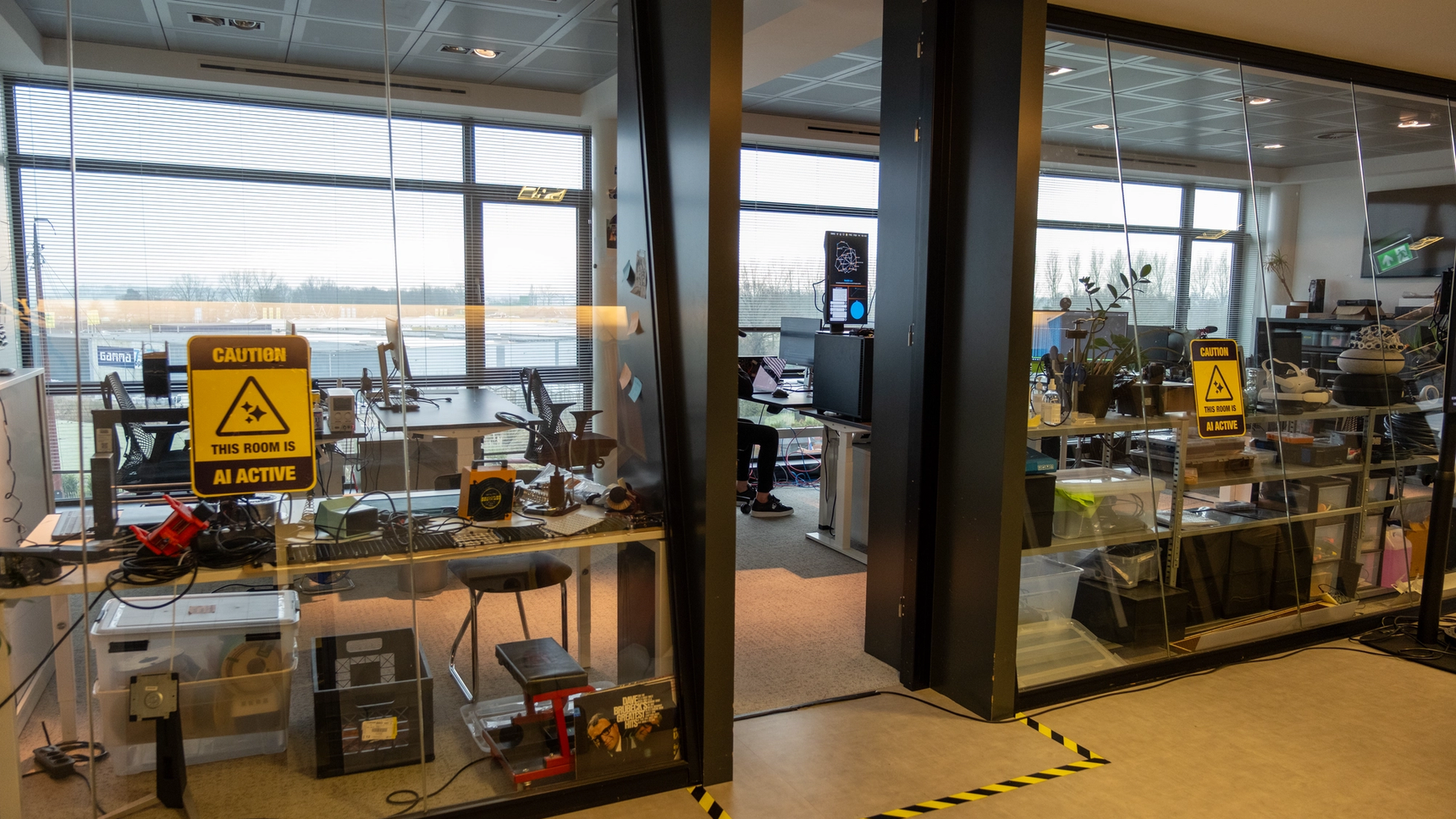
Daniel de Vos
Head of Data & AI
17 February 2025, 10 min
The hidden AI revolution: How mid-sized companies are quietly outperforming their larger rivals
The US plans to spend half a trillion dollars on strengthening its AI infrastructure in the year ahead. This recent announcement comes on top of $200 billion already invested last year by tech giants like Apple, Alphabet and Microsoft.
There’s no question that these investments will lead to more major breakthroughs in the future. But the real winners in the AI race right now are companies you don’t hear about in the news. They’re the mid-sized organizations who I see making outsized gains in productivity with targeted, strategic investments.
Your company doesn’t have to be a household name with a billion-dollar tech budget to get the maximum benefit out of AI. The latest generation of AI solutions are lowering the threshold, offering cost-effective, adaptable tooling for everything from automating customer support and optimizing marketing strategies to improving supply chain operations.
Below, I want to show you how embracing AI today is not only the right decision from a business perspective, it’s also much more achievable than many mid-sized companies may realize. I’ll cover some of the areas where you can already reap major benefits by implementing automatization and AI tools the right way. And I’ll share some of my first-hand insights into how to get started.
Outsized gains: The new 80/20 rule
As Head of Data & AI at Triple, part of Hypersolid, the most successful AI projects I've encountered, come from companies who aren’t trying to build the next ChatGPT. They’re focused on practical applications, and they understand one fundamental truth:
80% of productivity gains come from implementing AI in routine, everyday tasks that make up about 20% of operations
These organizations are seeing efficiency improvements by targeting what I call the “hidden time drains” – repetitive, non-strategic busy work that accumulates to hours of wasted time each day. We’re talking about simple actions performed countless times throughout the day, like adding tasks to your calendar, sending a follow-up email or entering data in your ERP or CRM. Or simply time-consuming, error-prone activities, like reading and understanding a lengthy report.
Gartner reports that by 2027, at least 30% of all work now performed by the average knowledge worker will be augmented by AI. In some areas, like customer support, marketing, finance and IT, that number will be much higher – and at some forward-thinking companies, it already is.
Use cases for AI: Finding the sweet spots
At Hypersolid, we’re constantly looking for ideal AI use cases that provide business impact. By that I mean “sweet spots” where AI can deliver major improvements with minimum implementation in time and cost.
For us, a worthwhile AI intervention always has to do at least one of these three things, all of which will create immediate business impact (I’ll also tell you further below about how we set our metrics):
- Boost creativity and improve business decisions
- Enable predictive and contextual insights that enhance our strategies
- Increase efficiency and save our agents time and resources
This approach is already paying off, and the list of examples is getting longer and longer:
After testing various solutions, we’ve fully transformed and automated many of our internal HR and marketing processes thanks to AI. Workflows that used to take up a lot of time to complete by hand are now completed instantly without a minute of manual labor.
We’re also testing tools for automatic code generation and debugging, which are now advanced enough to take care of routine tasks that we used to have to do by hand. These tools have already proven their worth on projects that require a high level of time-consuming customization.
We’ve even gone so far as to keep one of our meeting rooms permanently mic'd up, just to make sure our AI note-taker captures every meeting – and delivers us an instant transcript and summary, so nothing ever gets overlooked. Since those transcripts themselves are in data form (text), we can also crunch them into our favorite analysis and genAI tools to answer specific questions or double-check what was said or agreed upon.
Each organization has its own sweet spots where AI can have the greatest impact. By choosing tools that support your use case, you quickly recognize the potential of AI to transform business as usual. More importantly, you lay the foundations for your company’s AI-driven future.

Tools versus custom solutions: Which way to go?
For the sweet-spot use cases I mentioned above, you’ll notice that I mention we’re using ready-made, off-the-shelf tools rather than building our own custom solutions. That’s because these tools offer a fast, affordable and relatively low-risk entry point for deploying AI within a mid-sized company like ours.
That said, custom solutions can be indispensable when tackling edge cases. For example, integrating AI with systems like Enterprise resource planning (ERP) often requires a tailored approach because every company has unique software setups and requirements.
At Hypersolid, we always take a best-of-breed approach, which means choosing the right mix of ready-made tools and building customizations where they’re worthwhile. This enables us to move fast and keep costs under control while still maximizing the benefits of our AI interventions.
As a Data & AI partner to many major enterprises, we fully appreciate the value of building custom AI and machine learning solutions. After all, that’s a big part of what we do. But I’m here to say: you don’t have to wait for a fully custom-built solution to start reaping the benefits of AI. The tools are already there, and many of them come with powerful integrations right out of the box that can lead to big gains in productivity and profitability.
The AI journey in 3 phases
Like most companies, yours may already be exploring some of the possibilities. That’s great news, because it means you’re already setting the stage for the future holds. At the same time, it’s crucial to make the right choices now, as this will have an impact on how you progress along your AI journey.
Here’s what to watch out for:
Phase 1: Augmenting individual productivity (Now)
At Phase 1, individual employees (early adopters) within your company are experimenting with AI tools, but you lack overarching policies or preferred tools that are available to everyone. Although those early adopters might be boosting their own productivity, you need oversight and a consistent approach to ensure the maximum benefit. The key is to formalize these individual innovations into company-wide best practices.
One of the major benefits for mid-sized companies here is that they – unlike enterprises – often have much greater agility when it comes to making changes, enacting new policies and upskilling their workforce. Devoting time to getting the change management right at this stage is crucial to be well-positioned for Phase 2.
Phase 2: Team optimization (12 months later)
Here’s where the big benefits start to occur. As AI becomes part of your organization’s everyday culture, your teams will start standardizing workflows and tooling. This involves developing shared genAI prompts, templates, and guidelines that everyone follows. The focus is now on consistency, scalability, and shifting focus away from manual, repetitive tasks, and toward strategic, highly creative tasks.
For example, one of our clients at Hypersolid recognized the potential to save hours of work each week by automating a routine inventory management task: matching product codes and names from their own inventory log with a wide range of different codes and names used by their B2B customers. We developed a best-of-breed solution eliminating the need for manual product matching, automating this process for them successfully. At the moment, the client is already exploring how to apply the same technology in other areas of the business together with us.
Phase 3: Organizational transformation (18-24 months later)
Some companies will ultimately use AI to transform their operations from the ground up. So far, this phase has been limited to the tech giants and highly specialized firms, but it’s becoming increasingly accessible to mid-sized companies.
When your company reaches Phase 3, AI will be integrated into every process where applicable, from your supply chain to product development, investor relations and beyond. AI can also be leveraged to create self-healing IT platforms and systems, like the ones major tech firms like Adobe have been using for years. These maximize uptime and minimize maintenance needs.
Essentially any area where you’re now using human resources on slow-moving, manual tasks can be reimagined with the help of technology. At this point, your company is finally free to devote its human capital to maximum innovation and creativity, with the full support of automation and machine learning.

A paradigm shift for productivity
So, what happens when your company transitions to Phase 2 or Phase 3? At that point, it’s time to rethink your definition of productivity. Traditional productivity metrics have always focused on individual task completion. In the AI era, we’re going to need a new framework, which I call Amplified Intelligence Performance (AIP). Here are the metrics we’ll be tracking then:
- Speed multiplier: How much faster can we complete tasks?
- Quality enhancement: How much better are our outputs?
- Innovation potential: How much time is freed for creative work?
- Learning velocity: How quickly can we adapt and improve?
These metrics can already guide you as you choose which AI interventions are most beneficial to your company right now. New tools or strategies that score high on these metrics are almost certainly worth the investment. But it takes a systematic approach to be able to recognize how an AI tool will really help your company to grow and transform.
5 steps to successful AI implementation
Without a planned approach, it’s easy to lose track of what you’re really gaining from implementing an AI solution. To ensure you’re making the right moves, I recommend the following step-by-step action plan based on proven best practices:
- Audit: Document your current processes and how much time or resources you currently devote to each task.
- Identify: Determine the sweet spots (high-impact, low-risk processes that are ready for AI enhancement). Create clear metrics at this point for how you’ll evaluate the success of your efforts.
- Pilot: Test AI workflows with small teams.
- Refine: Gather feedback from the teams and optimize. Collect your findings into a playbook that can be used later when it’s time to scale the solution.
- Scale: Once a solution proves its value, it’s time to start rolling it out across the organization.
Beware of these pitfalls
The path to AI optimization isn’t always straightforward. Stay focused on what you’re trying to achieve and beware of these common traps that you might encounter along the way:
- Tool obsession: Focusing on making specific AI tools fits rather than allowing your business’s needs to determine the tools you choose.
- Scope creep: Trying to transform too many things – or everything – at once.
- Training gap: Not investing enough in education and support to make sure your entire team is along for the journey.
- Measurement failure: Not selecting or tracking the right metrics, leaving yourself with no way to tell whether your AI initiative is paying off.
No time to waste
As you can see, the real AI revolution is in full swing and it’s happening at forward-thinking organizations all over the world. If you’re looking to move your company to the next phase of its AI transformation, you’ll also benefit from expert advice from a partner who knows exactly where you’re coming from and where you want to go. At Hypersolid, we’ve been helping companies of all sizes to adopt and customize the right Data & AI solutions for their exact use cases.
We understand that AI transformation is not about replacing human labor or turning your operations upside down – it’s about freeing up human capabilities to focus on strategic thinking, so your organization stays competitive and future-facing. The organizations we’re helping to transform now will be the ones that thrive in the critical decade ahead.
The question is no longer “whether” to implement AI – it's how to do it in a way that creates lasting value while empowering your people to do their best work. By strategically building AI into your operations, you start to experience gains in efficiency which quickly turn into a competitive advantage. The key is to start now, start small, and start smart.
This perspective is part of our Hyperscale newsletter. Get the latest insights into the future by the people developing it. Subscribe now to stay ahead.
Perspectives
Industry insights, company updates, and groundbreaking achievements. Stories that drive Hypersolid forward.
Contact us and let's get started.

